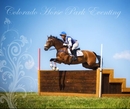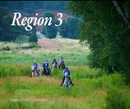
When taking photos of horses, one of the huge rules of thumb is to use a zoom lens. 100mm or more was a guideline I was once given and the longer the better. Wider angles distort the horse, often horribly. Huge noses and tiny legs... You see them everywhere in family pet snapshots and once you learn to see it, you find it often crops up in many artist's paintings and drawings because they were working from a photograph shot with a less than ideal zoom. I have dutifully stuck to this rule for ages with the exception of taking pictures in small spaces, such as the vet clinic exam and surgery rooms for documentary work.
 In my quest to give the horse event competitor the best and most unique shots of their horses, I constantly experiment with angles, shutter speed, depth of field, light and now lenses. I spent many years searching for the best angles from which to shoot horses in action or just hanging out. I know pretty much all of the "ideal" angles for which breeds, types of events and actions. AKA, the shots competitors expect to see from that discipline. They get boring after a while, especially when I can do them without even thinking. I have begun pushing the envelope, experimenting with less than cliche pictures in venues where I can.
In my quest to give the horse event competitor the best and most unique shots of their horses, I constantly experiment with angles, shutter speed, depth of field, light and now lenses. I spent many years searching for the best angles from which to shoot horses in action or just hanging out. I know pretty much all of the "ideal" angles for which breeds, types of events and actions. AKA, the shots competitors expect to see from that discipline. They get boring after a while, especially when I can do them without even thinking. I have begun pushing the envelope, experimenting with less than cliche pictures in venues where I can.
Over time I have tried to get in closer, pushing the limits of composition within the frame. I've tried slowing down the shutter speed to get interesting motion blurs. I also play with unique light when it's available and now I'm drawing back to show a place. Many show competitors are still looking for the same ol' same ol' and get uncomfortable with out of the norm shots. So I still strive to make them happy too but recently I have also been adding in a second camera with a wide angle lens to shake it up a little.
 Seems that many are able to appreciate the unique angles better than some of my slow motion blur experiments and I've played enough with the wide angle lens to figure out some viewpoints that really work well and plenty that are still so very, very much to be avoided. I'm enjoying being able to create competition images with a sense of place, as well as showing off the equine athlete in good form.
Seems that many are able to appreciate the unique angles better than some of my slow motion blur experiments and I've played enough with the wide angle lens to figure out some viewpoints that really work well and plenty that are still so very, very much to be avoided. I'm enjoying being able to create competition images with a sense of place, as well as showing off the equine athlete in good form.






